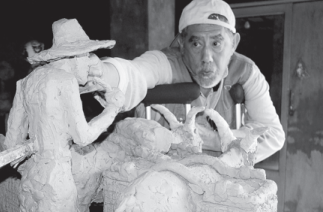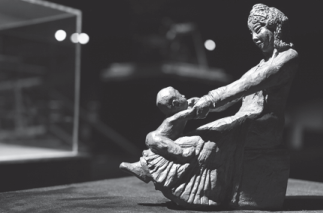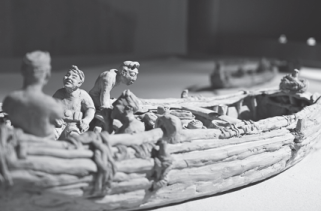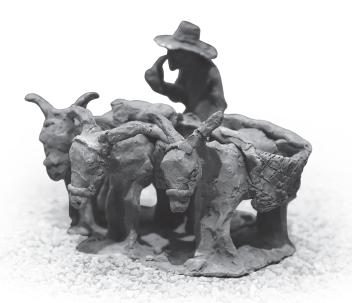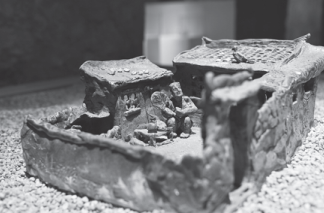Late sculptor Liu Shiming left an oeuvre that may seem quite unrefined and rustic to those whose tastes are sophisticated and are perhaps used to seeing a lot of polished and perfect pieces.
He largely produced monochromatic pottery, a feature of which is the rough texture showing the traces and marks left by his hands. His works form panoramic scenes of people from different walks of life going about their business: performers of local operas gathering backstage, boatmen working on the rivers, and street vendors and cobblers at roadside stands, to name a few.
Liu formed a distinctive style of freezing the most inconspicuous moments of these people's day-today lives, presenting them from a distant, peaceful perspective. The viewer ultimately feels "a simple concern with these people and a mood of sincerity that Liu hid deep within his work", says art critic Shao Dazhen.
Liu's passion for playing with clay is obvious. He once said that he didn't have any idea what he was creating before he laid his fingers on the clay.
"I experiment with the clay while I conceive. Only when I keep working with pottery can I become excited and have a great idea emerge in my mind," he said.
After Liu died in 2010 at age 84, his family donated dozens of his works to the Central Academy of Fine Arts in Beijing, the institution from which Liu graduated and where he once taught. Based on this donation, the school opened a gallery named after Liu with an exhibition showing more than 90 of his sculptures, photos, manuscripts, drafts and personal belongings on its Xiaoying campus in northern Beijing.
The ongoing exhibition will run until Jan 19, 2020. It will reopen on Feb 24 and continue until May 5, 2020.
The exhibition is dedicated to the critical period in Liu's career when he began to find his own sculptural language-the years between 1961 and the mid-1970s when he lived and worked in Henan and Hebei provinces, and frequently traveled to Shaanxi and Shanxi provinces.
He was extensively exposed to the diverse and rich customs in these regions, particularly the areas along the Yellow River. He was inspired to use clay to portray the dynamics of nature and life on the Loess Plateau, which he would continue for years, even after he was transferred back to Beijing in the late 1970s.
The exhibition hall is designed to resemble the interior of yaodong, or cave houses, a unique style of dwelling in northwestern China, and some of the sculptures are displayed on piles of sand and gravel to remind people of the windy, dry climate of the Loess Plateau.
Works on show include an "earthen courtyard" series Liu sculpted to convey his interest in the everyday routines of the people living in the enclosed, rectangular courtyards he saw along the Yellow River regions, including the distinctive dikengyuan-or "sunken courtyards"-that are dug below ground level.
The "ferryboat" series is another highlight from Liu's oeuvre that is on show. He depicted boatmen hard at work and a lively scene of passengers traveling with their heavy loads and livestock, through which he conveyed good wishes for these people.
Cao Qinghui, the exhibition's curator, says Liu's work embodies a humanistic spirit, and shows he valued mutual respect among people, and among humans, animals and nature, as well as a need to love and be loved.
Fan Di'an, principal of the Central Academy of Fine Arts, says that within Liu's body of work, the sculptures that depict the work and lives of everyday folk possess an intellectual seriousness in modeling and an academic tradition to present the spiritual nature of the subjects.
"He hailed from the working class, and he spared no effort to praise them in his work," Fan says.
"He sought no fame or fortune. He preferred to be far away from the spotlight and retreat to a world of his own for inner exploration. His art is deeply rooted in the soil of China's folk art and culture, especially those that were preserved in the countryside. He was nurtured with the brilliance of folk sculptures, and he opened his mind and heart to embrace the plain lifestyle of rural China and to feel its atmosphere.
"He therefore established a distinguished approach to art imbued with the delight of life, the emotional touch of shaping pottery with one's fingers and the warmth of the clay. By doing so, he also developed the 'Chinese methods' of sculpting."
Sculptor Wang Shaojun, a professor at the Central Academy of Fine Arts, says the opening of the exhibition and the gallery named after Liu is the beginning of a new course in which homegrown artists can learn from Liu's experiences. They can create work that also carries the cultural DNA of China and offers insightful perspectives into the realities and welfare of its people.
Liu once said: "Someday, after I die, my friends will have the opportunity to see my works and talk with them in silence. That will be lovely."
